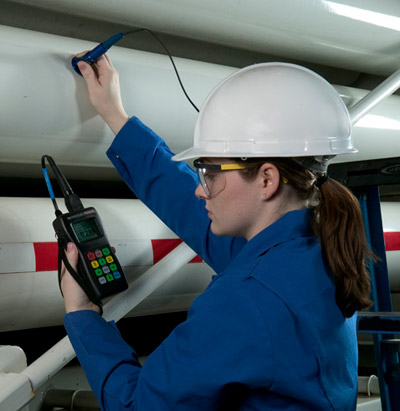Introduction to Ultrasonic Thickness Gauges

Introduction to Ultrasonic Thickness Gauges
For more than fifty years, ultrasonic thickness gauges have been used by quality control professionals to measure the thickness of a wide variety of products across a range of industries. This includes inspectors testing critical parts like aircraft turbine blades for wear and maintenance crews checking pipes and tanks for in-service corrosion. As hardware and software development has advanced over the years, ultrasonic thickness gauges have become powerful, reliable, and user-friendly tools. This tutorial describes how they work and what they are used for.
What Are Ultrasonic Thickness Gauges Used For?
Ultrasonic thickness gauges are often used to determine the thickness of a material where an inspector only has access to one side of the part, such as a pipe or tube, or where simple mechanical measurement is impossible or impractical due to the part’s size or access limitations. The fact that thickness measurements can quickly and easily be made from one side, with no need to cut parts, is one of the major advantages of this technology.
Virtually any common engineering material can be measured ultrasonically. Ultrasonic thickness gauges can be set up for metals, plastics, composites, fiberglass, ceramics, and glass. In-line or in-process measurement of extruded plastics and rolled metal is often possible, as is the measurement of individual layers or coatings in multilayer fabrications. Liquid levels and biological samples can also be measured. Ultrasonic gauging is always completely nondestructive, with no cutting or sectioning required. The range of measurement can be as large as 0.08 mm (0.003 in.) to 635 mm (25 in.) depending on material and transducer selection. Materials that are generally unsuitable for measurement with conventional ultrasonic gauges include wood, concrete, paper, and foam products.
Ultrasonic thickness gauges work by very precisely measuring how long it takes for a sound pulse that has been generated by a probe called an ultrasonic transducer to travel through a test piece. Because sound waves reflect from material boundaries, timing the echo from the far side of the test piece can be used to gauge its thickness, in the same way that radar or sonar measure distance. Resolution can be as fine as 0.001 mm or 0.0001 in.
Most ultrasonic thickness gauging applications use small, handheld transducers, but some complex geometries as well as in-line testing require noncontact transducers that focus a sound beam through a water column or bath. Measurements are essentially instantaneous and can be recorded on internal instrument data loggers for documentation or analysis.
What Materials Can Be Measured with an Ultrasonic Thickness Gauge?
Ultrasonic gauging can be used to measure corrosion, coatings, and a range of materials, most typically metals, plastics, composites, fiberglass, or ceramic glass.
Corrosion
If undetected over time, corrosion can weaken the structural integrity of metals like beams, bridge supports, and steel pilings. Ultrasonic thickness gauges can be used to nondestructively inspect metals to detect any damage or weakness that corrosion might have caused to metal structures.
Metals
Ultrasonic thickness gauges can be used to measure many metal products, including pipes and tanks, sheets and coils, gun drilling, or tubing. Ultrasonic gauging can be used for quality assurance purposes to ensure that manufacturing meets industry standards and that a product is safe and strong enough to perform its key function.
Plastics
The use of nonmetallic engineering products like plastics has become more common, increasing the need for wall thickness to be measured for quality control. Ultrasonic testing is now used on bottles and containers, plastic pipes, and fiberglass pipes and boats to ensure industry standards are accurately met and manufactured materials are safe to use.
Other Materials
Ultrasonic gauging can also be used for a variety of other materials. This includes rubber products, ceramics, glassware, and liquid level, where the user cannot access both sides of the material.